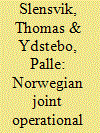| Srl | Item |
| 1 |
|
| 2 |
ID:
146916


|
|
|
|
|
| Summary/Abstract |
The second revision of the Norwegian Joint Operational Doctrine (NJOD) is an example of how a small state within the NATO framework presents a national ambition of conducting joint operations. Even if NATO doctrine is the cornerstone for the application of military force in Norway, there are some unique conditions and ambitions that Norway has chosen to put into its own doctrine. With the revision, Norway has institutionalized and formalized the doctrine process based upon the experience from earlier efforts and the NATO procedures. It has established a process that ensures a continuous doctrine cycle with few resources and can easily draw on more resources in a project-based development if need be. The process is discussed on the basis of the official minutes from the relevant meetings. This gives a unique insight in the process, and the challenges and solutions a small nation meets in creating national doctrines.
|
|
|
|
|
|
|
|
|
|
|
|
|
|
|
|